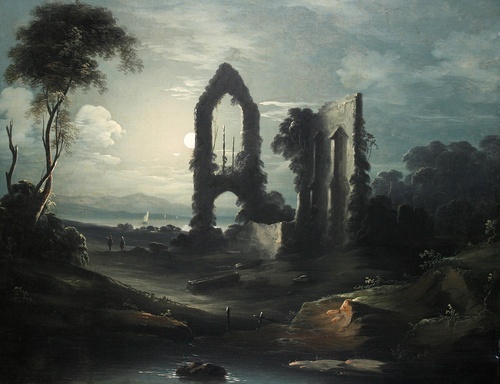

Sebastian Pether
GB
22
Artworks
1793 - 1844
Lifespan
Artist Biography
Sebastian Pether (1793–1844) was an English landscape painter renowned for his evocative depictions of moonlight, sunsets, and firelight, themes that established him as a prominent member of the "Moonlight Pethers," an artistic family that included his father, Abraham Pether, and his brother, Henry Pether. Born in London on November 24, 1793, and baptised at Saint Luke's Church, Chelsea, Sebastian inherited a strong artistic lineage, with his father also specializing in nocturnal scenes. From an early age, he was immersed in this specific genre, which would define his career and artistic identity, though his life was marked by considerable hardship and a constant struggle for financial stability.
As the eldest son, Sebastian William Thomas Pether received his artistic training directly from his father, Abraham, whose techniques and thematic preferences he closely followed. He quickly developed proficiency in capturing the subtle nuances of light and shadow, particularly the ethereal glow of the moon and the dramatic flicker of fire. However, Pether's personal life soon presented significant challenges. He married young and became the father of a large family, eventually having nine children. This domestic responsibility, coupled with limited opportunities for lucrative commissions or frequent exhibitions, forced him into a precarious reliance on art dealers who often exploited his desperate need for income, paying meager sums for his finely wrought canvases. Despite these pressures, Pether was a man of intellect and education, even laying claim to the original concept for the stomach-pump, an idea he reportedly proposed to the surgeon Andrew Jukes.
Petler's artistic output predominantly featured landscapes bathed in atmospheric effects, with a particular fondness for scenes illuminated by moonlight, the warm hues of sunset, or the dramatic intensity of fires. His works are often characterized by a romantic sensibility, sometimes venturing into "capricci" – imaginative architectural and topographical fantasies that appealed to Regency and early Victorian tastes. While some contemporary and later accounts note a tendency towards "greenish tones" in Sebastian's paintings, differentiating his palette slightly within the family's oeuvre, the broader Pether family style is also associated with the skilled use of chiaroscuro to create depth and drama. His ability to convey the mystery and sublime beauty of the nocturnal world was central to his appeal, even if the financial rewards were scant.
Throughout his career, Sebastian Pether found it difficult to secure consistent patronage or achieve widespread public acclaim through major art institutions. His works were exhibited at the Royal Academy, notably "View from Chelsea Bridge of the Destruction of Drury Lane Theatre" in 1814. Another significant piece, "A Caravan overtaken by a Whirlwind," was commissioned in 1826 by John Fleming Leicester, who stands out as Pether's only known consistent patron. Despite his talent and productivity, the art market of the time, especially for artists without strong connections or independent means, was harsh. His reliance on dealers meant his paintings were often sold quickly and cheaply, providing little respite from his financial woes. A particularly disheartening episode occurred in the spring of 1842 when three of his pictures, submitted to the Royal Academy with the assistance of a frame-maker, were rejected, highlighting his ongoing struggle for recognition.
The latter part of Pether's life was overshadowed by profound personal tragedy and relentless financial strain. He endured the loss of three of his grown children to consumption, and shortly after his own death, another son succumbed to lockjaw; his eldest son, William, pursued a career as a mosaic artist. These devastating losses, compounded by the constant pressure to support his large family, undoubtedly took a heavy toll on his well-being. Sebastian Pether died relatively young, at the age of 51, on March 14, 1844, at York Cottage, Battersea Fields, London, succumbing to an "inflammatory attack." His death left his surviving family in a state of destitution, necessitating a public subscription to raise funds for their support. Years later, in November 1876, a charity appeal was even made in The London Times for his surviving daughter, who was said to be destitute after ruining her eyesight working as a needlewoman.
Sebastian Pether's legacy is that of a talented artist who, despite a life fraught with adversity, consistently produced captivating landscapes that skillfully explored the interplay of light and darkness. As one of the "Moonlight Pethers," he contributed to a distinctive family tradition in British art. However, his work has sometimes been subject to misattribution, frequently confused with that of his brother, Henry Pether, whose paintings were generally signed and considered more realistic and refined. Sebastian's story is a poignant reminder of the economic vulnerabilities faced by many artists in the 19th century. While he never achieved the financial success or widespread fame of some contemporaries, his paintings remain appreciated for their atmospheric beauty, their romantic evocation of night, and the quiet drama they convey, securing his place as a notable figure among English landscape painters of his era.